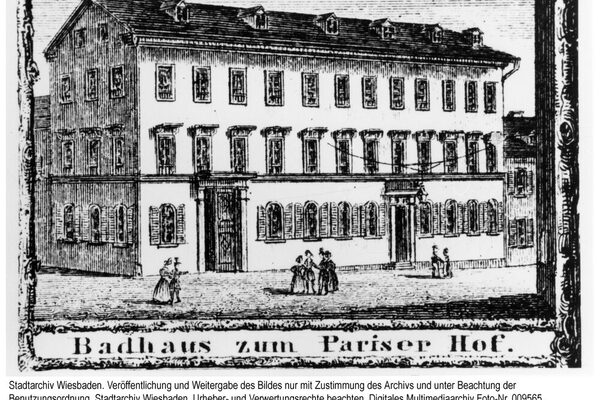Parisian Court
The Spiegelgasse 9 building from 1832 is the only neoclassical bathhouse still standing today. There is evidence of a bathhouse on this site since the first half of the 16th century. It was destroyed and rebuilt several times and was given the name Zum Rebhuhn. In 1724, the Jew Jekof became the owner of the Rebhuhn, which thus took on the function of a Jewish bathhouse and was obliged to take in poor, sick Jews. In 1732-90, the Rebhuhn also became the seat of the synagogue.
The current building at Spiegelgasse 11 was built in 1735 by the owner of the neighboring Firnselmühle, Valentin Krug. The systematic expansion of Wiesbaden into a spa town after 1800 forced the old-established innkeepers to adapt their houses to modern standards. The new owner, Isaak Jakob Hiffelsheimer, had the Rebhuhn and the neighboring corner house on the left demolished in 1831 and a new three-storey building erected. He gave it the contemporary name "Pariser Hof". The façade has remained almost unchanged, only the stucco ornaments and putti above the windows were added around 1900. The Jewish owner Hiffelsheimer had to lease the house to the Christian tenant Freinsheim for financial reasons, and in 1837 it was bought by the court councillor Friedrich von Wagner. After that, the Pariser Hof was no longer a Jewish bath, but according to some reports, its bathing cabins were still used as a mikvah from time to time, even after 1945.
In 1844, Wagner acquired the building from 1735, and in a further sale in 1852, the (present-day) houses at Spiegelgasse 9 and 11 passed to different owners; they have been under one ownership again since 1929. In 1860/61, the hall of the Pariser Hof served as a place of worship for the German Catholic community, to which the then owner Anna Maria Bücher belonged. While the Pariser Hof was still considered competitive with the first hotels in the 1842 spa guide, it was assigned to a lower category around 1900. The Hotel Pariser Hof was used until the 1930s, when the Wehrmacht took up residence there. In 1945, the American occupying forces housed the publishing houses here that they had transferred from Leipzig to Wiesbaden. The newly founded Limes publishing house (headed by Max Niedermayer) was also housed here. It remained loyal to Spiegelgasse for the longest time and was relocated to Munich in 1973.
The baths remained open in the post-war period and were gratefully used by the publishing house representatives and their guests, including Walter Kempowski, who worked in a US store in the Opelhaus in 1947. There was a thermal bath on the first floor until the 1990s. After the publishers moved out, hotel operations were resumed until 1982. From 1986 to 2014, the cultural tradition of the building was continued by the Pariser Hoftheater.
The city of Wiesbaden acquired the building complex due to its historical significance. Spiegelgasse 11 was renovated in 1999. In 2008/09, the Spiegelgasse 9 building was renovated and redesigned, and the bathing facilities were extended. The Active Museum Spiegelgasse Association for German-Jewish History in Wiesbadenfor German-Jewish History in Wiesbaden uses No. 11 for exhibitions and has had its office in No. 9 since fall 2009.
Literature
Czysz, Walter: Vom Römerbad zur Weltkurstadt, Geschichte der Wiesbadener heißen Quellen und Bäder, Wiesbaden 2000 (Schriften des Stadtarchivs Wiesbaden 7) [p. 335 ff.]
Jung, Wolfgang: From Jewish bathhouse to cabaret stage. The "Pariser Hof". In: Everyday life between the powerful and the idle [pp. 41-46].
Fritzsche, Wolfgang: From the bathhouse "Zum Rebhuhn" to the home of the Paul Lazarus Foundation. The history of a former Jewish bathhouse. In: Faber/Fritzsche, Jewish Buildings.
Fritzsche, Wolfgang: 300 years of Jewish bathing in Wiesbaden. A contribution to the Jewish history of Wiesbaden. Edited by: Schneider, Karlheinz, Wiesbaden 2014 (Paul Lazarus Schriftenreihe IV).
